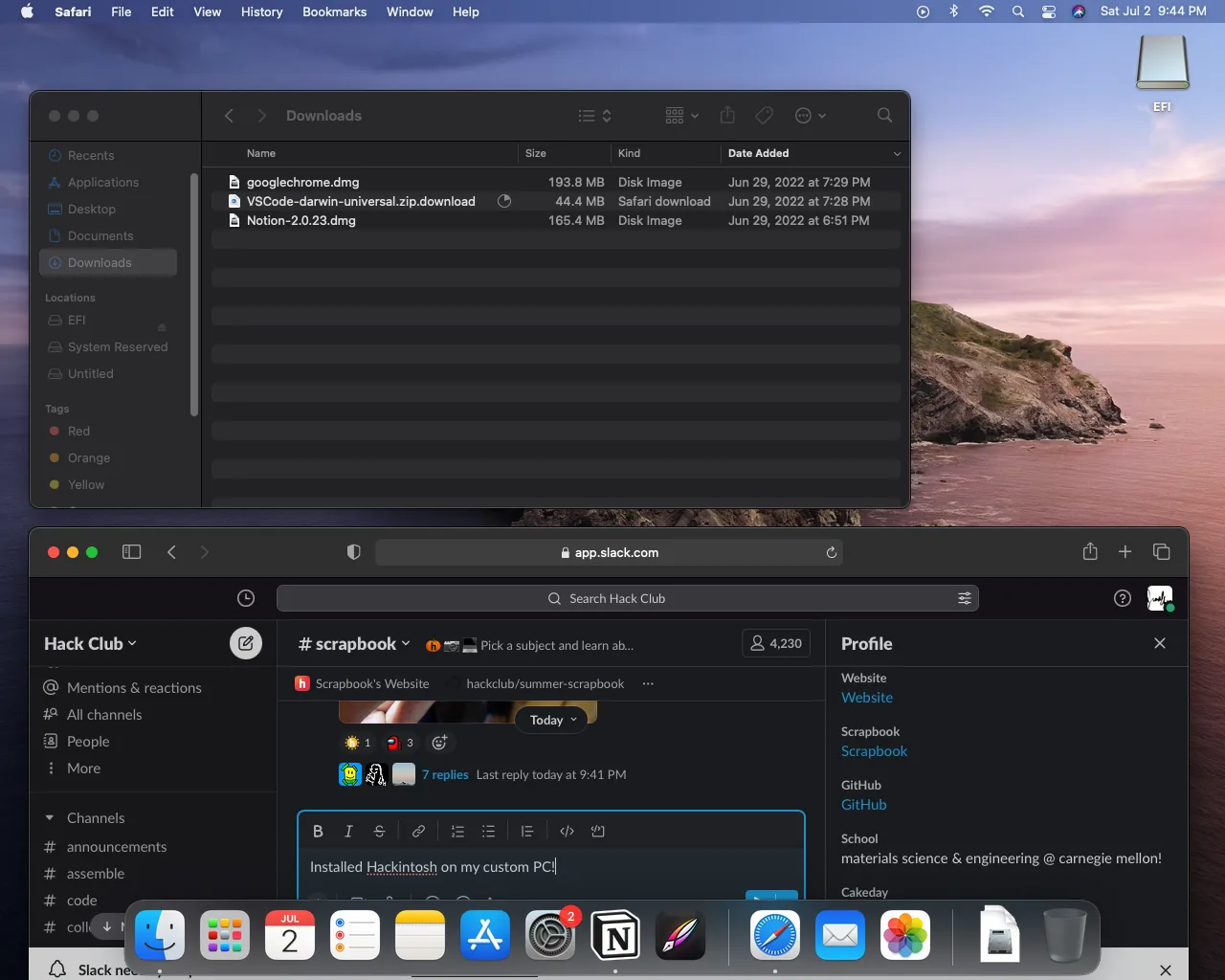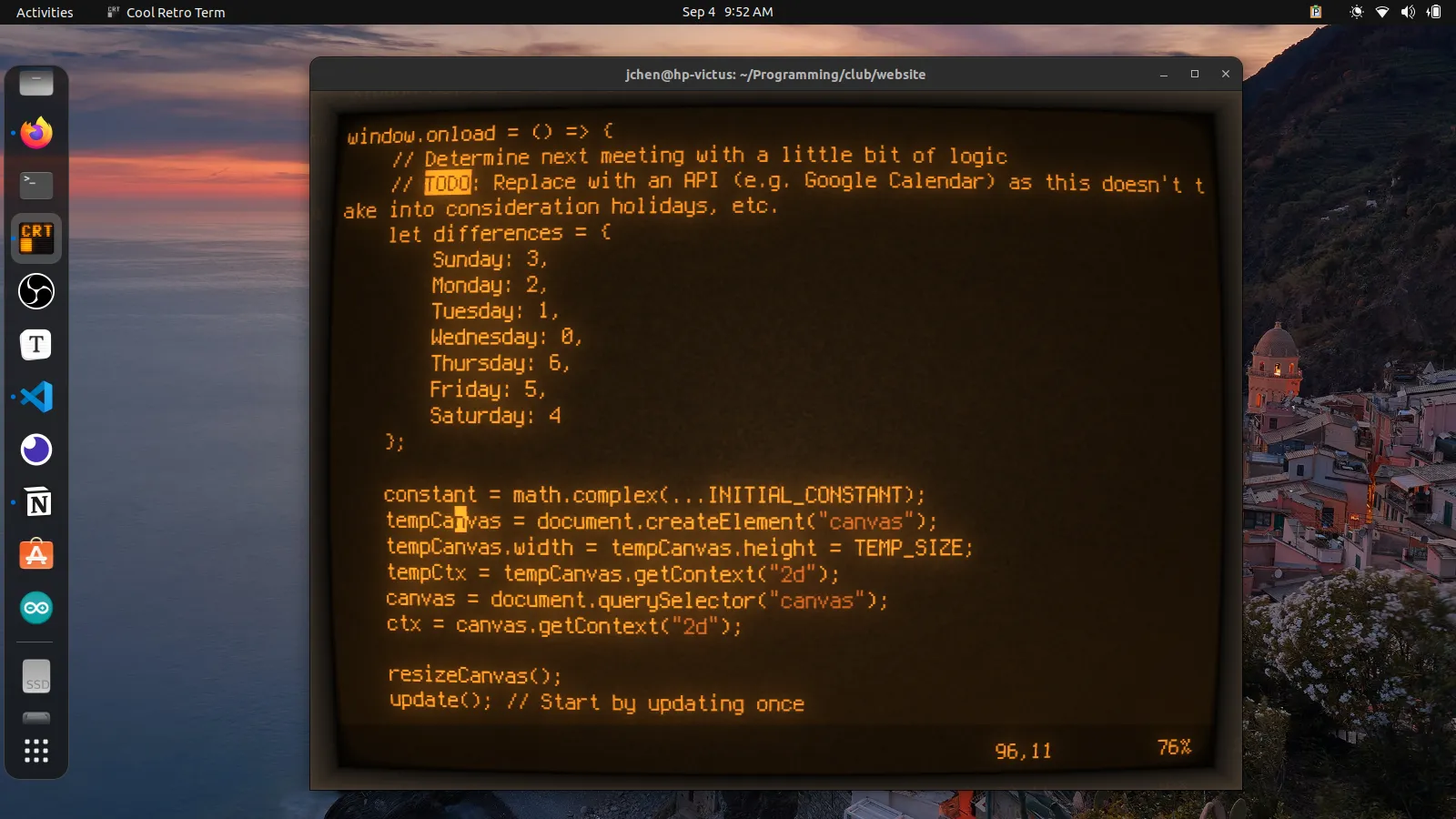← Back to articles
Geeking out over specs
2022-09-04 · 7 min read
When I started programming, I was using a Dell Inspiron 15 from 2013. I have upgraded since, thankfully. Currently, I am writing this on an HP Victus 15 with the following specs:
- Intel i5-12450H, with 8 cores, 12 threads running up to 4.4GHz when overclocked (which I haven't actually tried out, as ~3 GHz is good enough for me)
- 8GB RAM, not including 4GB RAM that I added, for a total of 12GB
- NVIDIA GeForce GTX 1650 with 4GB
- 512GB SSD
- 15" screen
My Dell Inspiron was 15 inches too, but can't live up to Victus in any way (think: Intel i3 with 4 cores running up to 1.92GHz, 4GB RAM, integrated graphics, and a 240GB HDD). It was bought in 2013 somewhere in the range of $500 - $600. I bought my laptop, including the add-on RAM, for ~$594 total, including tax. Isn't that absolutely insane? Moore's law definitely has been put into perspective for me.
 Stickers galore on my laptop!
Stickers galore on my laptop!
I actually have a custom desktop too that I built sometime last summer. I salvaged the monitor, an extremely old HP monitor from 2005 or 2006 (somewhere in that time range - aka when I was born) that I found outside in somebody's yard with the sign "FREE" next to it. The keyboard is also salvaged - I got it for free from my school's IT workshop since they were getting new keyboards. So I ended up shelling out around ~$800 for the rest of the components:
- The case, a Cooler Master case for ~$45 (I just checked again and it's $70, what the f**k? Inflation, my man) This one is cool because it allows ATX motherboards to fit in, by changing the position of the PSU plug.
- The CPU, a AMD Ryzen 5 with 6 cores, 12 threads running up to 3.6GHz for ~$130 (thankfully, only $140)
- 8GB of RAM for ~$50 (checked and it's only $38 now)
- The GPU, a NVIDIA GeForce GTX 710 with 2GB for ~$105 (just checked and it's only $89, the graphics card market is cooling down at least)
- The SSD, a 240GB SSD from Kingston for ~$35 (only $22 right now)
- The motherboard, a Gigabyte B450 Aorus Pro ATX motherboard with WiFi built-in for ~$116 (relatively the same price at the time of writing)
- The PSU, a Thermaltake 500W PSU for ~$50 (only $35 now, so that's nice)
- Side accessories
 Don't mind the wires - I'm just doing a bit of moving around!
Don't mind the wires - I'm just doing a bit of moving around!
Also, I know I just got a laptop, but I really, really find the Framework laptops super cool because they're semi-DIY! Too bad I found out about it after I got my laptop. Oh, well. They're having shortages, so...
Mobile devices
I used to have an iPhone 6s, but after getting annoyed that I couldn't install the apps I wanted on it for an agonizing amount of time, I finally got a Google Pixel 6a this summer. I've seen some bad reviews for it so far online, but it's been pretty good for me so far. Or maybe it's because my standards are lower than everyone else's, considering the fact that I did have an iPhone 6s prior to getting a new phone. Regardless, it was a decent deal - I ended up spending ~$498 for everything, case and all. Specs:
- Google Tensor CPU. Which I admit to knowing nothing about.
- 6GB RAM. How is this possible. My Inspiron had 4GB of RAM. Moore's Law put into perspective, once again.
- 6.1" diagonally, which is about the same size as my old phone
- Decent cameras. Probably not the best considering I've used the camera on an iPhone 13 Pro Max (or is it Max Pro? Who knows) before (not mine), but it's okay for the price. I mean, there's two back cameras.
In other words, if you're planning on getting an iPhone (aka it's in your budget), get one. If your budget means you're looking at the iPhone SE, probably consider this instead. At the very least, the screen is bigger.
Software
Okay, software. I've jumped between a bunch of different operating systems over the course of the last two years. On my old Dell Inspiron, I used Windows 8 and 8.1, but you know what? They suck as much as Windows 11.
Yes, my new laptop has Windows 11 installed on it by default. What the heck? Why are the design decisions so bad? Okay, this isn't a post about how much Windows sucks, so we'll move on.
On my laptop, I'm currently dual booting Windows 11 and Ubuntu 22.04, which is absolutely gorgeous both in terms of aesthetics and features. On my desktop, I'm running Windows 10 in the trial version (I obviously won't pay for the actual version) and Hackintosh. However, I accidentally wiped the flash drive I used to boot Hackintosh... so I don't exactly use it anymore. I really want to get Hackintosh running on my laptop, but Apple is completely incompatible with NVIDIA graphics, so that will never work. Other OSes I've used in the past include PopOS, which is a derivative of Ubuntu, and at the time of this writing, I am trying to install Kali Linux (mostly because I really want to try out some of the cool tools it comes with).
 Hackintosh in action!
Hackintosh in action!
Tools
Okay, tools. Here's what I use most of the time:
- VSCode. I used to use Atom but decided to switch over, considering that Atom is being discontinued. I think it's ironically funny that both of them technically belong under Microsoft open source, since GitHub, the company behind Atom, is basically owned by Microsoft.
- Vim. I'm trying to get into using Vim a little bit more for two reasons: one, it's cool, and two, the concept that it makes you more productive is true. Currently, my strategy for learning Vim is to use it for small projects that only have a couple of files, and slowly learn how to use it by doing a lot of Googling every time I'm stuck. Update: Wow, I'm actually getting better at it! I'm currently updating it with Vim, where I have multiple split windows. Plus, I've installed my first Vim plugin,
vim-gitgutterto view Git changes in the editor gutter. And I've figured how to set the theme! Super cool. I might get into Neovim in the future. - Parcellite. This is basically a clipboard history tool for Linux. I'm super used to using Windows + V on Windows to bring up a clipboard (given that it's enabled, obviously), so I had to find an alternative to it. Parcellite is pretty good for my needs.
- OBS Studio & Kdenlive, the latter of which I've never actually had to use.
- Firefox first and foremost, then Chrome for extra testing, since I will admit that more people use Chrome.
- Insomnia instead of Postman for testing APIs, because it's open source.
NotionI now use Markright, a minimal, Markdown-based writing tool that I built using a DIY Markdown parser. Because reinventing the wheel is, surprisingly, fun.
 Vim on Cool Retro Term (retro terminals)!
Vim on Cool Retro Term (retro terminals)!
There's a couple of tools I have installed, like:
- Arduino IDE
- LibreOffice: Open source version of Microsoft Office.
- Krita: Open source drawing tool. Replaces Vectornator, Adobe Illustrator, etc.
- OBS Studio + Kdenlive + Audacity: OBS Studio is used for recording videos, Kdenlive is used for editing videos, and Audacity is used for editing sound... the whole recording cycle, basically. I've only ever really used OBS Studio so far, but I definitely want to learn more about the other tools.
But I don't really use these, so. That's about it.
Hey! This is a post forever in progress. In other words, I'm probably going to tweak it once in a while, because things do change.